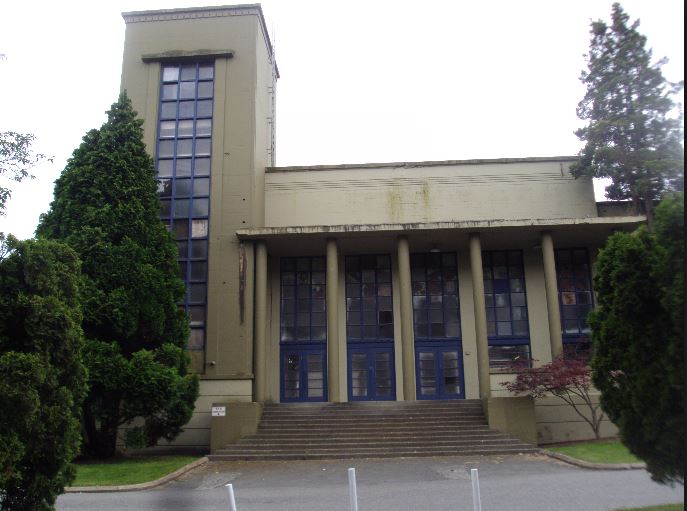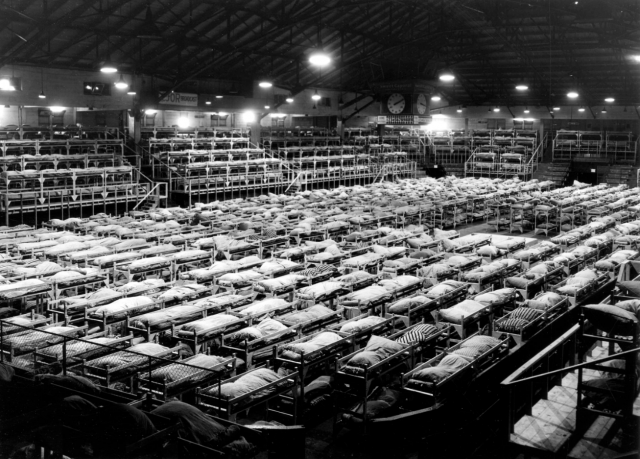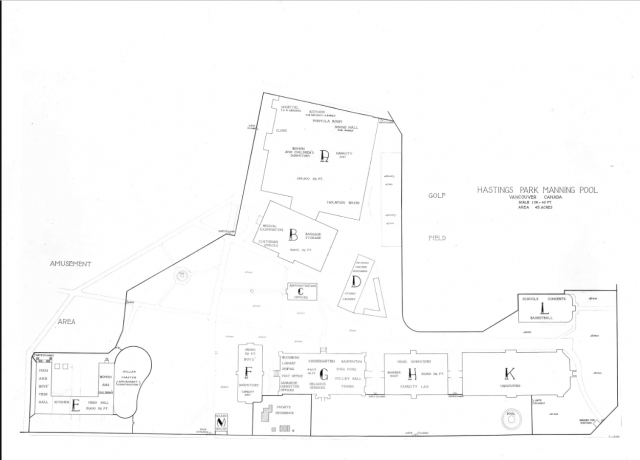From Vancouver Exposed: Searching for the City’s Hidden History

Hastings Park:
The Livestock Building at Hastings Park is a rundown old concrete warehouse full of peeling paint, boarded up and broken windows. The back is just as neglected, but painted red from a film shoot some years ago. Most of us know it from taking our kids to see the petting zoo, the pig races and Big Bob at the annual Pacific National Exhibition. And, while it’s in desperate need of a face lift, the building has got both architectural merit and a really interesting social history.

Internment:
The first part of the building went up in 1929, and then in the ‘40s architectural firm McCarter Nairne turned it into a much larger Streamline Moderne building—the same firm that designed the amazing art deco Marine Building on Burrard.
Most important though is the building serves as a reminder of the injustice suffered by 22,000 Japanese-Canadians during WW2. From March to September, 1942 you would have found more than 3,100 women and children at different times living in deplorable conditions in the animal stalls at the western end of this three-acre large building. The eastern section housed a hospital, kitchen and dining area. The men–mostly fishers and miners and merchants and foresters were housed in the Pure Food Building.

PNE buildings:
All told there were at least 10 of the PNE buildings used to house the Japanese Canadians in disgusting conditions. Most of the buildings are long gone, but as well as the Livestock building, Rollerland, the Forum, the Garden Auditorium and the race track were all used at some point to contain the Japanese before they were shipped off to internment camps.
These “enemy aliens”–many who were born in Canada–were wrenched from their homes and sent to live here before being forcibly relocated to internment camps in places like Slocan, BC.
Wander through the Momiji Gardens and you’ll find a faded plaque secured to a rock telling some of the story.
Muriel Fujiwara Kitagawa described the Japanese women’s dormitory: “The whole place is impregnated with the smell of ancient manure and maggots. Every other day it is swept with dichlorine of lime, or something, but you can’t disguise horse smell, cow smell, sheep, pigs, rabbits and goats…there are 10 showers for 1,500 women.”

Back in 1997 when it looked like the PNE and Playland would move somewhere else, the Garden Auditorium (1940), the PNE Forum (1933), the iconic wooden rollercoaster (early 1930s) and the Livestock Building were all under threat of demolition. A decision to keep the PNE where it is gave these structures a reprieve.
According to Dave Hutch, project manager, the City of Vancouver is currently assessing the Livestock Building before recommending that it be added to the Vancouver Heritage Register. Hutch, says based on the research so far, the building will likely qualify for an A Status, which at the very least should help the former marshalling facility get the maintenance it badly needs to prolong its life.
© All rights reserved. Unless otherwise indicated, all blog content copyright Eve Lazarus.



6 comments on “The Livestock Building at the PNE”
Please support more horse and agricultural events on the PNE grounds 🙂
The “Japanese Problem” of 1942 was presented in September 2017 in a drama at the livestock building. You can read about it here: http://www.cbc.ca/news/canada/british-columbia/the-history-is-not-safely-in-the-past-play-explores-wartime-japanese-detainment-1.4301442
I heard (somewhere),that someone hung themself from a beam. Can you verify? Thank you
[…] that nine of the 196 panels that were restored for the 2010 Olympics and will be on display in the Livestock Building this year. The rest of the map is stored in an Air Canada hangar at […]
[…] Patricia Hotel, 403 East Hastings; Spencer’s Department Store (now SFU at Harbour Centre); the Livestock Building at the PNE, and the General Post Office on West […]
[…] the same architects that designed the Devonshire Hotel, Georgia Medical and Dental Centre and the Livestock building, designed the Marine Building—the first high rise office tower in the city. The architect’s […]